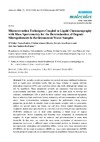Identificador persistente para citar o vincular este elemento:
https://accedacris.ulpgc.es/jspui/handle/10553/12133
| Título: | Microextraction techniques coupled to liquid chromatography with mass spectrometry for the determination of organic micropollutants in environmental water samples | Autores/as: | Padrón, Ma Esther Torres Afonso-Olivares, Cristina Sosa-Ferrera, Zoraida Santana-Rodríguez, José Juan |
Clasificación UNESCO: | 2301 química analítica | Palabras clave: | Organic micropollutants Water samples Pesticides Pharmaceuticals Personal care products, et al. |
Fecha de publicación: | 2014 | Publicación seriada: | Molecules | Resumen: | Until recently, sample preparation was carried out using traditional techniques, such as liquid–liquid extraction (LLE), that use large volumes of organic solvents. Solid-phase extraction (SPE) uses much less solvent than LLE, although the volume can still be significant. These preparation methods are expensive, time-consuming and environmentally unfriendly. Recently, a great effort has been made to develop new analytical methodologies able to perform direct analyses using miniaturised equipment, thereby achieving high enrichment factors, minimising solvent consumption and reducing waste. These microextraction techniques improve the performance during sample preparation, particularly in complex water environmental samples, such as wastewaters, surface and ground waters, tap waters, sea and river waters. Liquid chromatography coupled to tandem mass spectrometry (LC/MS/MS) and time-of-flight mass spectrometric (TOF/MS) techniques can be used when analysing a broad range of organic micropollutants. Before separating and detecting these compounds in environmental samples, the target analytes must be extracted and pre-concentrated to make them detectable. In this work, we review the most recent applications of microextraction preparation techniques in different water environmental matrices to determine organic micropollutants: solid-phase microextraction SPME, in-tube solid-phase microextraction (IT-SPME), stir bar sorptive extraction (SBSE) and liquid-phase microextraction (LPME). Several groups of compounds are considered organic micropollutants because these are being released continuously into the environment. Many of these compounds are considered emerging contaminants. These analytes are generally compounds that are not covered by the existing regulations and are now detected more frequently in different environmental compartments. Pharmaceuticals, surfactants, personal care products and other chemicals are considered micropollutants. These compounds must be monitored because, although they are detected in low concentrations, they might be harmful toward ecosystems. | URI: | https://accedacris.ulpgc.es/handle/10553/12133 | ISSN: | 1420-3049 | DOI: | 10.3390/molecules190710320 | Fuente: | Molecules,v. 19, p. 10320-10349 | Derechos: | by-nc-nd |
| Colección: | Reseña |
Los elementos en ULPGC accedaCRIS están protegidos por derechos de autor con todos los derechos reservados, a menos que se indique lo contrario.
